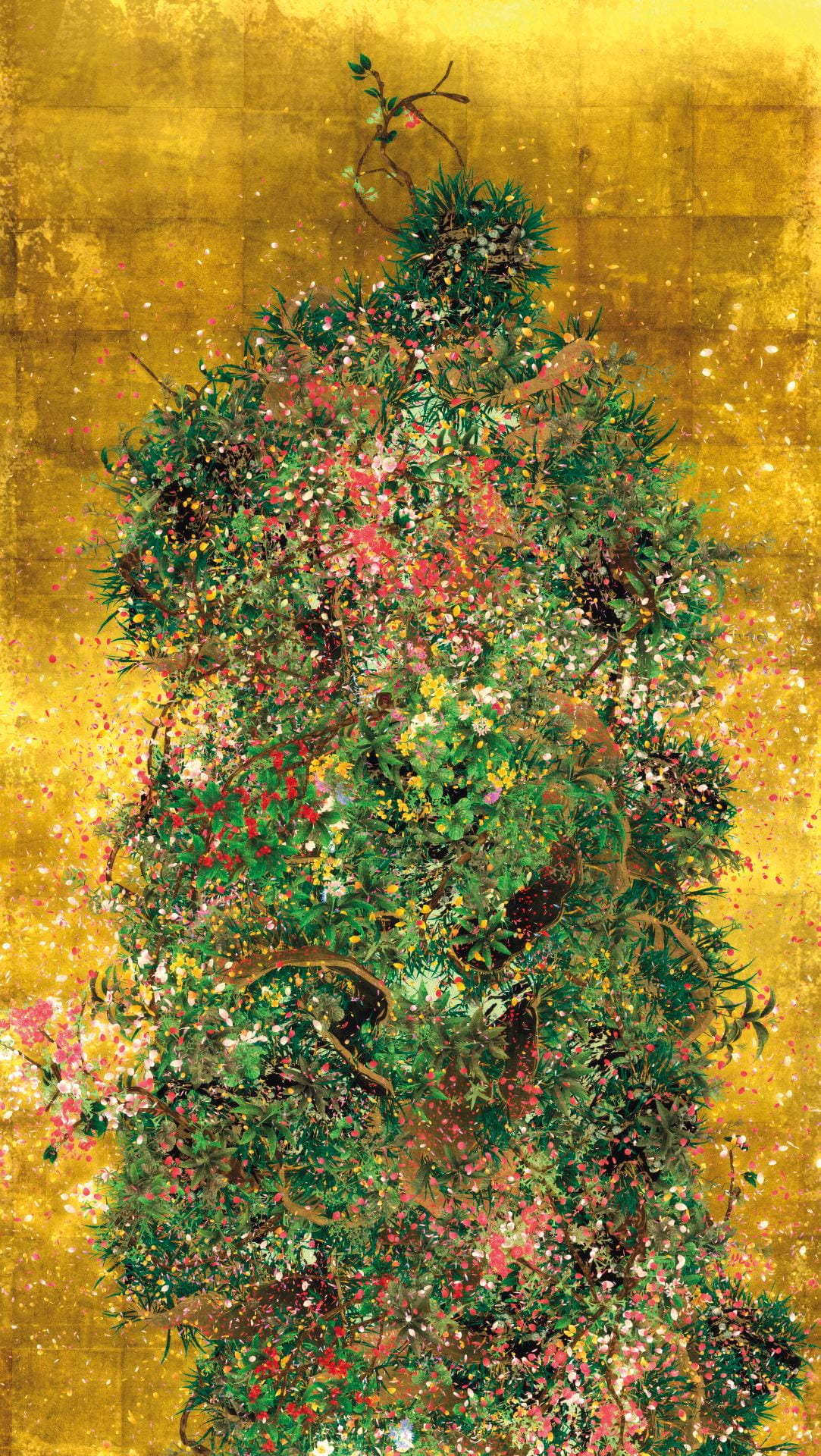
Currently on view at the William Eckhardt Research Center at the University of Chicago
teamLab, Ever Blossoming Life – Gold (2014)
Ever Blossoming Life – Gold (2014) by teamLab (f. 2001) is an extension of the artists’ practice of transcending the boundaries between humans and nature by drawing connections between the self and the world. In the software-based digital artwork, the Tokyo-based interdisciplinary art collective portrays the transient nature of human lives through the lifespan of flowers. As viewers immerse themselves in the continuously progressing images of the work, it becomes noticeable that the work is not a mere replay of a pre-recorded video. Rather, it is an assemblage of momentary visuals constantly produced, drawn, and displayed via algorithms crafted by the group of artists, programmers, engineers, and architects —pioneers bridging art and technology for an immersive viewing experience. As the real time production of their computer program features a distinct image at every second, constantly recreating itself, what is shown to each viewer becomes unique and unrepeatable, reflecting on the irreversible nature of our lives. As the artists themselves put it, “previous states are never duplicated” in the world we live in.
Read More
The idea of the transience of nature is in fact a reference to the wabi-sabi principles of Japanese traditional aesthetics. Wabi refers to the beauty of aged things, while sabi speaks to the impermanence of life through the passage of time. Together, the two principles serve as the core values of the aesthetics of Japan, the nation in which the artists’ cultural roots lie. The principles of wabi-sabi also form a common theme in Japanese landscape traditions, as, for example, in the Edo Period work Bird and Chrysanthemum (n.d.; c. Edo Period) by Gyokuho Hasegawa, a treasure from the collection of the Smart Museum of Art (see related links).
A close look into the visual qualities of its images reveals further references to Japanese aesthetic traditions. The yellowish-golden background with its uneven marks of faint, sketchy brushstrokes reminds viewers of kinpaku (gold leaf), a material frequently used in Japanese traditional painting and craft. Simultaneously, the gold color also echoes the landscape painting tradition of the Tosa School, a genre of Japanese painting developed in the 14th–15th century, which is characterized by decorative compositions on a brown-gold background.
teamLab further heightens the work’s connection with the art-historical tradition of Japan by evoking the distinctly East Asian sense of spatial recognition. Unlike the Western painting convention in which objects recede in space and therefore create multiple levels of depths, Japanese traditional composition depicts figures on a single plane of depth, attributing a horizontal relationship to all figures in the frame.
Ever Blossoming Life – Gold (2014) follows such an alternative convention of composition by producing a 2-dimensional planarity that allows the viewers to hold a flowing-eye movement throughout the screen.
Such a two-fold feature of the work – its Japanese visual qualities and the algorithmic endeavors that went into its making – highlights how a digital artwork can invoke various cultural forms to the viewers through both medium-specific and transmedia features, as mentioned by Patrick Jagoda, a digital media theorist and game designer at the University of Chicago.
The relationship between the digital artwork and its recurring references to traditional cultural principles speaks to teamLab’s aim of bridging the past and present as a means of envisioning the future. In the work, technology serves as the medium to recreate traditional values that are gradually diminishing in the digital age we live in. Thereby, giving them new life in the contemporary space, rather than preserving them as a mere ornament. It is the convergence between tradition and innovation that the collective believes to be the key for society with a purpose. As Toshiyuki Inoko, the founder of the collective emphasizes in his interviews, we should not limit ourselves to focusing on technological advancement, but should rather utilize such advancement to reflect on our past and retain the values that are crucial to our cultural history.
Artist Profile

teamLab
International art collective, founded in 2001 by Toshiyuki Inoko, Japan
In 2001, eight years before analog television was converted to digital, six years before the release of the iPhone, and just one year after broadband replaced dial-up, Toshiyuki Inoko (born 1977) graduated from the University of Tokyo’s Department of Mathematical Engineering with the belief that the future would be digital. He founded teamLab that same year with a small group of friends who shared this belief.
From a modest start-up to a global multidisciplinary collaboration with more than 600 hundred participants, this Tokyo-based collective consists of artists, programmers, engineers, and architects who refer to themselves as ‘ultra-technologists’—pioneers bridging art and technology for an immersive viewing experience. As they declare in their creative statement, their aim is to “Explore the relationship between the self and the world and new perceptions through art.” They have hit their mark with venues that span the globe. From Milan, to Paris, London, Tokyo, New York, and Mumbai, a broad range of people with diverse backgrounds connect through shared experience while viewing the work of teamLab.
Related Links
Smart Museum of Art, Bird and Chrysanthemum (1822-1879)
Pritzker School Arts, Sciences and Technology
